Clustering Business Models of Heterogeneous Nature-Based Solutions Implementing Innovative Governance and Financing Concepts
Abstract
:1. Introduction
2. Materials and Methods
2.1. Data Collection
2.2. Nature-Based Sustainability Business Model Canvas
2.3. Analysis Approach
3. Results
3.1. NBS between the State, Market, and Community
3.2. NBS Business Model Clusters
3.2.1. Cluster Public Provision
City-Internal Public Provision
City-Led Public Provision
3.2.2. Diversified Cluster
3.2.3. Sales Cluster
3.3. Financial Benefits
3.4. Degree of Profit Orientation
3.5. Main Target Groups
4. Discussion
5. Conclusions
Supplementary Materials
Author Contributions
Funding
Data Availability Statement
Conflicts of Interest
References
- Cohen-Shacham, E.; Walters, G.; Janzen, C.; Maginnis, S. Nature-Based Solutions to Address Global Societal Challenges; IUCN: Gland, Switzerland, 2016; pp. xii + 97. [Google Scholar] [CrossRef]
- Raymond, C.M.; Frantzeskaki, N.; Kabisch, N.; Berry, P.; Breil, M.; Nita, M.R.; Geneletti, D.; Calfapietrah, C. A framework for assessing and implementing the co-benefits of nature-based solutions in urban areas. Environ. Sci. Policy 2017, 77, 15–24. [Google Scholar] [CrossRef]
- Keesstra, S.; Nunes, J.; Novara, A.; Finger, D.; Avelar, D.; Kalentari, Z.; Cerdà, A. The superior effect of nature based solutions in land management for enhancing ecosystem services. Sci. Total Environ. 2018, 610–611, 997–1009. [Google Scholar] [CrossRef] [PubMed]
- Almenar, J.B.; Elliot, T.; Rugani, B.; Philippe, B.; Gutierrez, T.N.; Sonnemann, G.; Geneletti, D. Nexus between nature-based solutions, ecosystem services and urban challenges. Land Use Policy 2021, 100, 104898. [Google Scholar] [CrossRef]
- European Commission. Topics: Nature-Based Solutions. Available online: https://research-and-innovation.ec.europa.eu/research-area/environment/nature-based-solutions_en (accessed on 8 March 2022).
- Li, Y.; Wang, G.; Chen, T.; Zhang, R.; Zhou, L.; Yan, L. Nature-Based Solutions in “Forest–Wetland” Spatial Planning Strategies to Promote Sustainable City Development in Tianjin, China. Land 2022, 11, 1227. [Google Scholar] [CrossRef]
- Mell, I.; Clement, S.; O’Sullivan, F. Mainstreaming Nature-Based Solutions in City Planning: Examining Scale, Focus, and Visibility as Drivers of Intervention Success in Liverpool, UK. Land 2023, 12, 1371. [Google Scholar] [CrossRef]
- Larrey-Lassalle, P.; Armand Decker, S.; Perfido, D.; Naneci, S.; Rugani, B. Life Cycle Assessment Applied to Nature-Based Solutions: Learnings, Methodological Challenges, and Perspectives from a Critical Analysis of the Literature. Land 2022, 11, 649. [Google Scholar] [CrossRef]
- Sowińska-Świerkosz, B.; Wójcik-Madej, J.; Michalik-Śnieżek, M. An Assessment of the Ecological Landscape Quality (ELQ) of Nature-Based Solutions (NBS) Based on Existing Elements of Green and Blue Infrastructure (GBI). Sustainability 2021, 13, 11674. [Google Scholar] [CrossRef]
- Sowińska-Świerkosz, B.; Garcia, J. What are Nature-based solutions (NBS)? Setting core ideas for concept clarification. Nat. Based Solut. 2022, 2, 100009. [Google Scholar] [CrossRef]
- Mahmoud, I.H.; Morello, E.; Lemes de Oliveira, F.; Geneletti, D. Nature-Based Solutions for Sustainable Urban Planning: Greening Cities, Shaping Cities; Springer: Cham, Switzerland, 2022. [Google Scholar] [CrossRef]
- Devanand, V.B.; Mubeen, A.; Vojinovic, Z.; Sanchez Torres, A.; Paliaga, G.; Abdullah, A.F.; Leitão, J.P.; Manojlovic, N.; Fröhle, P. Innovative Methods for Mapping the Suitability of Nature-Based Solutions for Landslide Risk Reduction. Land 2023, 12, 1357. [Google Scholar] [CrossRef]
- Anderson, V.; Suneja, M.; Dunjic, J. Sensing and Measurement Techniques for Evaluation of Nature-Based Solutions: A State-of-the-Art Review. Land 2023, 12, 1477. [Google Scholar] [CrossRef]
- Mayor, B.; Toxopeus, H.; McQuaid, S.; Croci, E.; Lucchitta, B.; Reddy, S.E.; Egusquiza, A.; Altamirano, M.A.; Trumbic, T.; Tuerk, A.; et al. State of the Art and Latest Advances in Exploring Business Models for Nature-Based Solutions. Sustainability 2021, 13, 7413. [Google Scholar] [CrossRef]
- Egusquiza, A.; Arana-Bollar, M.; Sopelana, A.; Babí Almenar, J. Conceptual and Operational Integration of Governance, Financing, and Business Models for Urban Nature-Based Solutions. Sustainability 2021, 13, 11931. [Google Scholar] [CrossRef]
- Kabisch, N.; Korn, H.; Stadler, J.; Bonn, A. Nature-Based Solutions for Societal Goals Under Climate Change in Urban Areas—Synthesis and Ways Forward. In Nature-Based Solutions to Climate Change Adaptation in Urban Areas; Springer: Cham, Switzerland, 2017; pp. 323–336. [Google Scholar] [CrossRef]
- Maes, J.; Liquete, C.; Teller, A.; Erhard, M.; Paracchini, M.L.; Barredo, J.I.; Grizzetti, B.; Cardoso, A.; Somma, F.; Petersen, J.-E.; et al. An indicator framework for assessing ecosystem services in support of the EU Biodiversity Strategy to 2020. Ecosyst. Serv. 2016, 17, 14–23. [Google Scholar] [CrossRef]
- Faivre, N.; Fritz, M.; Freitas, T.; De Boissezon, B.; Vandewoestijne, S. Nature-Based Solutions in the EU: Innovating with nature to address social, economic and environmental challenges. Environ. Res. 2017, 159, 509–518. [Google Scholar] [CrossRef] [PubMed]
- ProGIreg. Project Information. Available online: www.proGIreg.eu (accessed on 10 June 2023).
- Papina, C.; Budau, O.E.; Olbertz, M. Collaboration in planning nature-based solutions: Replication tools for place-based urban regeneration. In Proceedings of the 57th Isocarp World Planning Congress, Doha, Qatar, 8–11 November 2021; Available online: https://progireg.eu/fileadmin/user_upload/20210915_Collaboration_in_planning_nature-based_solutions_Case_study_report_ISOCARP_conference.pdf (accessed on 10 May 2023).
- Leopa, E.; Elisei, P.; Budau, E. Spatial Analysis in Front Runner and Follower Cities. ProGIreg Deliverable 2.2 2020. Available online: https://progireg.eu/fileadmin/user_upload/Deliverables/D.2.2_proGIreg_SpatialAnalysis_2020-07-28.pdf (accessed on 13 April 2023).
- Opačak, M.; Wang, E. Estimating Willingness to Pay for a Future Recreational Park Atop the Current Jakuševec Landfill in Zagreb, Croatia. Sustainability 2019, 11, 6038. [Google Scholar] [CrossRef]
- Długoński, A.; Dushkova, D. The Hidden Potential of Informal Urban Greenspace: An Example of Two Former Landfills in Post-Socialist Cities (Central Poland). Sustainability 2021, 13, 3691. [Google Scholar] [CrossRef]
- Ascione, G.S.; Cuomo, F.; Mariotti, N.; Corazza, L. Urban Living Labs, Circular Economy and Nature-Based Solutions: Ideation and Testing of a New Soil in the City of Turin Usinga Multi-stakeholder Perspective. Circ. Econ. Sustain. 2021, 1, 545–562. [Google Scholar] [CrossRef]
- Dogan, E.; Cuomo, F.; Battisti, L. Reviving Urban Greening in Post-Industrial Landscapes: The Case of Turin. Sustainability 2023, 15, 12760. [Google Scholar] [CrossRef]
- Anderson, V.; Gough, W.A. A Typology of Nature-Based Solutions for Sustainable Development: An Analysis of Form, Function, Nomenclature, and Associated Applications. Land 2022, 11, 1072. [Google Scholar] [CrossRef]
- Ilieva, R.T.; Cohen, N.; Israel, M.; Specht, K.; Fox-Kämper, R.; Fargue-Lelièvre, A.; Poniży, L.; Schoen, V.; Caputo, S.; Kirby, C.K.; et al. The Socio-Cultural Benefits of Urban Agriculture: A Review of the Literature. Land 2022, 11, 622. [Google Scholar] [CrossRef]
- Kingsley, J.; Egerer, M.; Nuttman, S.; Keniger, L.; Pettitt., P.; Frantzeskaki, N.; Gray, T.; Ossola, A.; Lin, B.; Bailey, A.; et al. Urban agriculture as a nature-based solution to address socio-ecological challenges in Australian cities. Urban For. Urban Green. 2021, 60, 127059. [Google Scholar] [CrossRef]
- Wadumestrige Dona, C.G.; Mohan, G.; Fukushi, K. Promoting Urban Agriculture and Its Opportunities and Challenges—A Global Review. Sustainability 2021, 13, 9609. [Google Scholar] [CrossRef]
- Canet-Martí, A.; Pineda-Martos, R.; Junge, R.; Bohn, K.; Paço, T.A.; Delgado, C.; Alenčikienė, G.; Skar, S.L.G.; Baganz, G.F.M. Nature-Based Solutions for Agriculture in Circular Cities: Challenges, Gaps, and Opportunities. Water 2021, 13, 2565. [Google Scholar] [CrossRef]
- Junge, R.; König, B.; Villarroel, M.; Komives, T.; Jijakli, M.H. Strategic Points in Aquaponics. Water 2017, 9, 182. [Google Scholar] [CrossRef]
- Mayrand, F.; Clergeau, P. Green Roofs and Green Walls for Biodiversity Conservation: A Contribution to Urban Connectivity? Sustainability 2018, 10, 985. [Google Scholar] [CrossRef]
- Liberalesso, T.; Cruz, C.O.; Silva, C.M.; Manso, M. Green infrastructure and public policies: An international review of green roofs and green walls incentives. Land Use Policy 2020, 96, 104693. [Google Scholar] [CrossRef]
- Sang, A.O.; Thorpert, P.; Fransson, A.-M. Planning, Designing, and Managing Green Roofs and Green Walls for Public Health–An Ecosystem Services Approach. Front. Ecol. Evol. 2022, 10, 804500. [Google Scholar] [CrossRef]
- Wang, H.; Pei, Z. Urban Green Corridors Analysis for a Rapid Urbanization City Exemplified in Gaoyou City, Jiangsu. Forests 2020, 11, 1374. [Google Scholar] [CrossRef]
- Jiang, Y.; Huang, J.; Shi, T.; Li, X. Cooling Island Effect of Blue-Green Corridors: Quantitative Comparison of Morphological Impacts. Int. J. Environ. Res. Public Health 2021, 18, 11917. [Google Scholar] [CrossRef]
- Sarabi, S.; Han, Q.; De Fries, B.; Romme, A.G.L. The nature-based solutions planning support system: A playground for site and solution prioritization. Sustain. Cities Soc. 2022, 78, 103608. [Google Scholar] [CrossRef]
- Frantzeskaki, N. Seven lessons for planning nature-based solutions in cities. Environ. Sci. Policy 2019, 93, 101–111. [Google Scholar] [CrossRef]
- Pineda-Pinto, M.; Frantzeskaki, N.; Nygaard, C.A. The potential of nature-based solutions to deliver ecologically just cities: Lessons for research and urban planning from a systematic literature review. Ambio 2021, 51, 167–182. [Google Scholar] [CrossRef] [PubMed]
- Bush, J.; Doyon, A. Building urban resilience with nature-based solutions: How can urban planning contribute? Cities 2019, 95, 102483. [Google Scholar] [CrossRef]
- Ballamy, C.; Van der Jagt, A.P.N.; Barbour, S.; Smith, M.; Moseley, D. A spatial framework for targeting urban planning for pollinators and people with local stakeholders: A route to healthy, blossoming communities? Environ. Res. 2017, 158, 255–268. [Google Scholar] [CrossRef]
- Capotorti, G.; Valeri, S.; Giannini, A.; Minorenti, V.; Piarulli, M.; Audisio, P. On the Role of Natural and Induced Landscape Heterogeneity for the Support of Pollinators: A Green Infrastructure Perspective Applied in a Peri-Urban System. Land 2023, 12, 387. [Google Scholar] [CrossRef]
- Larcher, F.; Baldacchini, C.; Ferracini, C.; Vercelli, M.; Ristorini, M.; Battisti, L.; Calfapietra, C. Nature-Based Solutions as Tools for Monitoring the Abiotic and Biotic Factors in Urban Ecosystems. In Urban Services to Ecosystems; Catalano, C., Andreucci, M.B., Guarino, R., Bretzel, F., Leone, M., Pasta, S., Eds.; Springer: Cham, Switzerland, 2021; Volume 17. [Google Scholar] [CrossRef]
- Osterwalder, A. The Business Model Ontology—A Proposition in a Design Science Approach. Ph.D. Thesis, University of Lausanne, Lausanne, Switzerland, 2004. [Google Scholar]
- Osterwalder, A.; Pigneur, Y. Business Model Generation: A Handbook for Visionaries, Game Changers, and Challengers; John Wiley & Sons: Hoboken, NJ, USA, 2010; ISBN 978-0470-87641. [Google Scholar]
- George, G.; Bock, A.J. The business model in practice and its implications for entrepreneurship research. Entrep. Theory Pract. 2009, 35, 83–111. [Google Scholar] [CrossRef]
- Weiller, C.; Neely, A. Business Model Design in an Ecosystem Context. 2013. Available online: https://cambridgeservicealliance.eng.cam.ac.uk/system/files/documents/2013JunepaperBusinessModelDesigninEcosystemContext.pdf (accessed on 6 February 2023).
- Goffetti, G.; Böckin, D.; Baumann, H.; Tillman, A.-M.; Zobel, T. Towards sustainable business models with a novel life cycle assessment method. Bus. Strategy Environ. 2022, 31, 2019–2035. [Google Scholar] [CrossRef]
- Schaltegger, S.; Lüdeke-Freund, F.; Hansen, E.G. Business Models for Sustainability: A Co-Evolutionary Analysis of Sustainable Entrepreneurship, Innovation, and Transformation. Organ. Environ. 2016, 29, 264–289. [Google Scholar] [CrossRef]
- Yang, M.; Vladimirova, D.; Evans, S. Creating and Capturing Value Through Sustainability. Res. Technol. Manag. 2017, 60, 30–39. [Google Scholar] [CrossRef]
- Broccardo, L.; Zicari, A. Sustainability as a driver for value creation: A business model analysis of small and medium enterprises in the Italian wine sector. J. Clean. Prod. 2020, 259, 120852. [Google Scholar] [CrossRef]
- Ferlito, R.; Faraci, R. Business model innovation for sustainability: A new framework. Innov. Manag. Rev. 2022, 19, 222–236. [Google Scholar] [CrossRef]
- Boons, F.; Lüdeke-Freund, F. Business models for sustainable innovation: State-of-the-art and steps towards a research agenda. J. Clean. Prod. 2013, 45, 9–19. [Google Scholar] [CrossRef]
- Islam, M.T.; Iyer-Raniga, U. Circular Business Model Value Dimension Canvas: Tool Redesign for Innovation and Validation through an Australian Case Study. Sustainability 2023, 15, 11553. [Google Scholar] [CrossRef]
- Bockarjova, M.; Botzen, W.J.W.; Koetse, M.J. Economic Valuation of green and blue nature in cities: A meta-analysis. Ecol. Econ. 2020, 169, 106480. [Google Scholar] [CrossRef]
- Jacobs, S.; Dendoncker, N.; Martín-López, B.; Barton, D.N.; Gomez-Baggethun, E.; Boeraeve, F.; McGrath, F.L.; Vierikko, K.; Geneletti, D.; Sevecke, K.J.; et al. A new valuation school: Integrating diverse values of nature in resource and land use decisions. Ecosyst. Serv. 2016, 22 Pt B, 213–220. [Google Scholar] [CrossRef]
- Croci, E.; Lucchitta, B.; Penati, T. Valuing Ecosystem Services at the Urban Level: A Critical Review. Sustainability 2021, 13, 1129. [Google Scholar] [CrossRef]
- Connecting Nature. Project Information. Available online: https://connectingnature.eu/ (accessed on 10 June 2023).
- Naturvation. Project Information. Available online: https://naturvation.eu/ (accessed on 10 June 2023).
- Toxopeus, H.S. Taking Action for Urban Nature: Business Model Catalogue. Naturvation Guide. 2019. Available online: https://naturvation.eu/sites/default/files/results/content/files/business_model_catalogue.pdf (accessed on 25 March 2022).
- Connecting Nature. Nature-Based Solutions Business Model Canvas Guidebook. 2019. Available online: https://connectingnature.eu/sites/default/files/downloads/NBC-BMC-Booklet-Final-%28for-circulation%29.pdf (accessed on 3 May 2022).
- Nature4cities. Project Information. Available online: https://www.nature4cities.eu/ (accessed on 10 May 2023).
- Bischof, A. Diamond Model User Guide. Available online: https://www.edicitnet.com/wp-content/uploads/Diamond-Model-User-Guide.pdf (accessed on 10 April 2023).
- UNaLab Business Models & Financing Strategies. D6.3 Deliverable 30/11/2018. Available online: https://unalab.eu/system/files/2020-05/d63-business-models-and-financing-strategies2020-05-18.pdf (accessed on 10 May 2022).
- Droste, N.; Schröter-Schlaack, C.; Hansjürgens, B.; Zimmermann, H. Implementing Nature-Based Solutions in Urban Areas: Financing and Governance Aspects. In Nature-Based Solutions to Climate Change Adaptation in Urban Areas. Theory and Practice of Urban Sustainability Transitions; Kabisch, N., Korn, H., Stadler, J., Bonn, A., Eds.; Springer: Cham, Switzerland, 2017. [Google Scholar] [CrossRef]
- Tozer, L.; Hörschelmann, K.; Anguelovski, I.; Bulkeley, H.; Lazova, Y. Whose city? Whose nature? Towards inclusive nature-based solution governance. Cities 2020, 107, 102892. [Google Scholar] [CrossRef]
- Albert, C.; Schröter, B.; Haase, D.; Brillinger, M.; Henze, J.; Herrmann, S.; Gott-wald, S.; Guerrero, P.; Nicolas, C.; Matzdorf, B. Addressing societal challenges through nature-based solutions: How can land-scape planning and governance research contribute? Landsc. Urban Plan. 2019, 182, 12–21. [Google Scholar] [CrossRef]
- Van der Jagt, A.P.N.; Raven, R.; Dorst, H.; Runhaar, H. Nature-based innovation systems. Environ. Innov. Soc. Trans. 2019, 35, 202–216. [Google Scholar] [CrossRef]
- Boscherini, L.; Chiaroni, D.; Chiesa, V.; Frattini, F. How to use pilot projects to implement open innovation. Int. J. Innov. Manag. 2010, 14, 1065–1097. [Google Scholar] [CrossRef]
- Stork, S.; Morgenstern, R.; Pölling, B.; Feil, J.-H. Holistic Business Model Conceptualisation—Capturing Sustainability Contributions Illustrated by Nature-Based Solutions. Sustainability 2023, 15, 14091. [Google Scholar] [CrossRef]
- Pestoff, V. Third sector and co-operative services–An alternative to privatization. J. Consum. Policy 1992, 15, 21–45. [Google Scholar] [CrossRef]
- Pestoff, V.A. Beyond the Market & State: Social Enterprise and Civil Democracy in a Welfare Society; Ashgate Pub Ltd.: Aldershot, UK, 1998; ISBN-13: 978-1840145755. [Google Scholar]
- Pestoff, V.A. A Democratic Architecture for the Welfare State; Routledge: London, UK, 2008. [Google Scholar] [CrossRef]
- Defourny, J.; Nyssens, M. The Emes Approach of Social Enterprise in a Comparative Perspective. 2014. Available online: https://www.researchgate.net/publication/295367694_The_emes_approach_of_social_enterprise_in_a_comparative_perspective (accessed on 21 May 2023).
- Pestoff, V.A. Hybridity, Coproduction, and Third Sector Social Services in Europe. Am. Behav. Sci. 2014, 58, 1412–1424. [Google Scholar] [CrossRef]
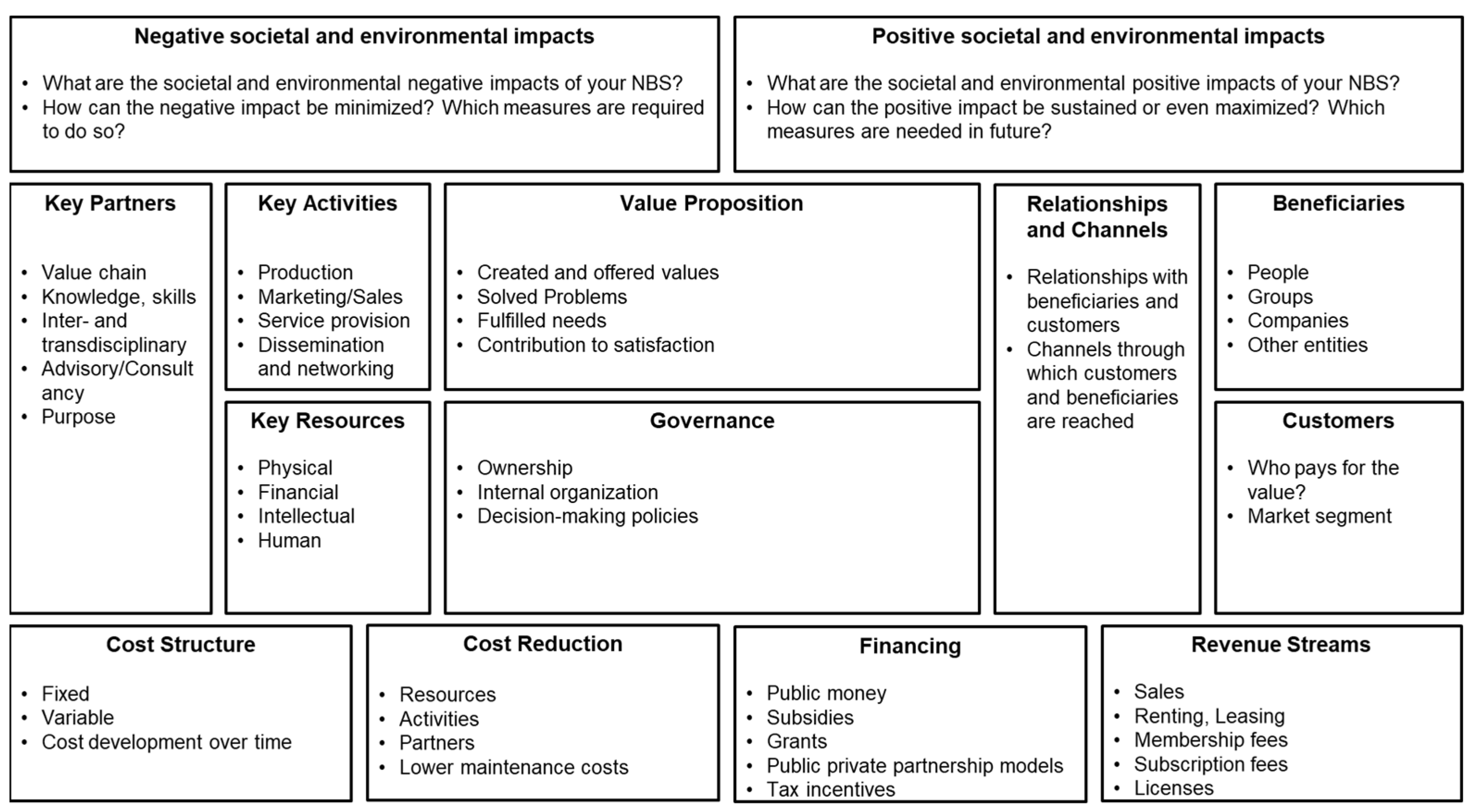
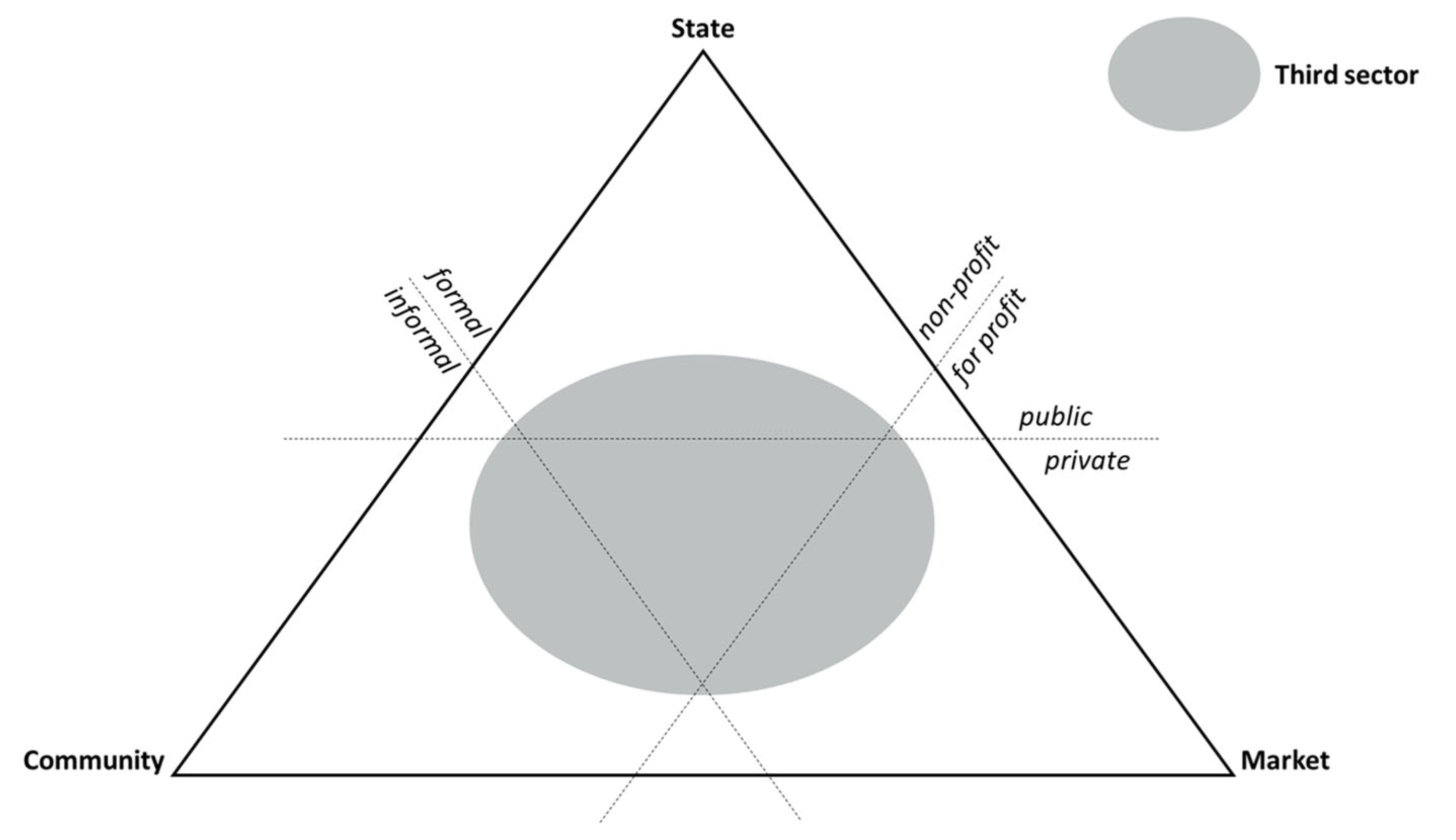
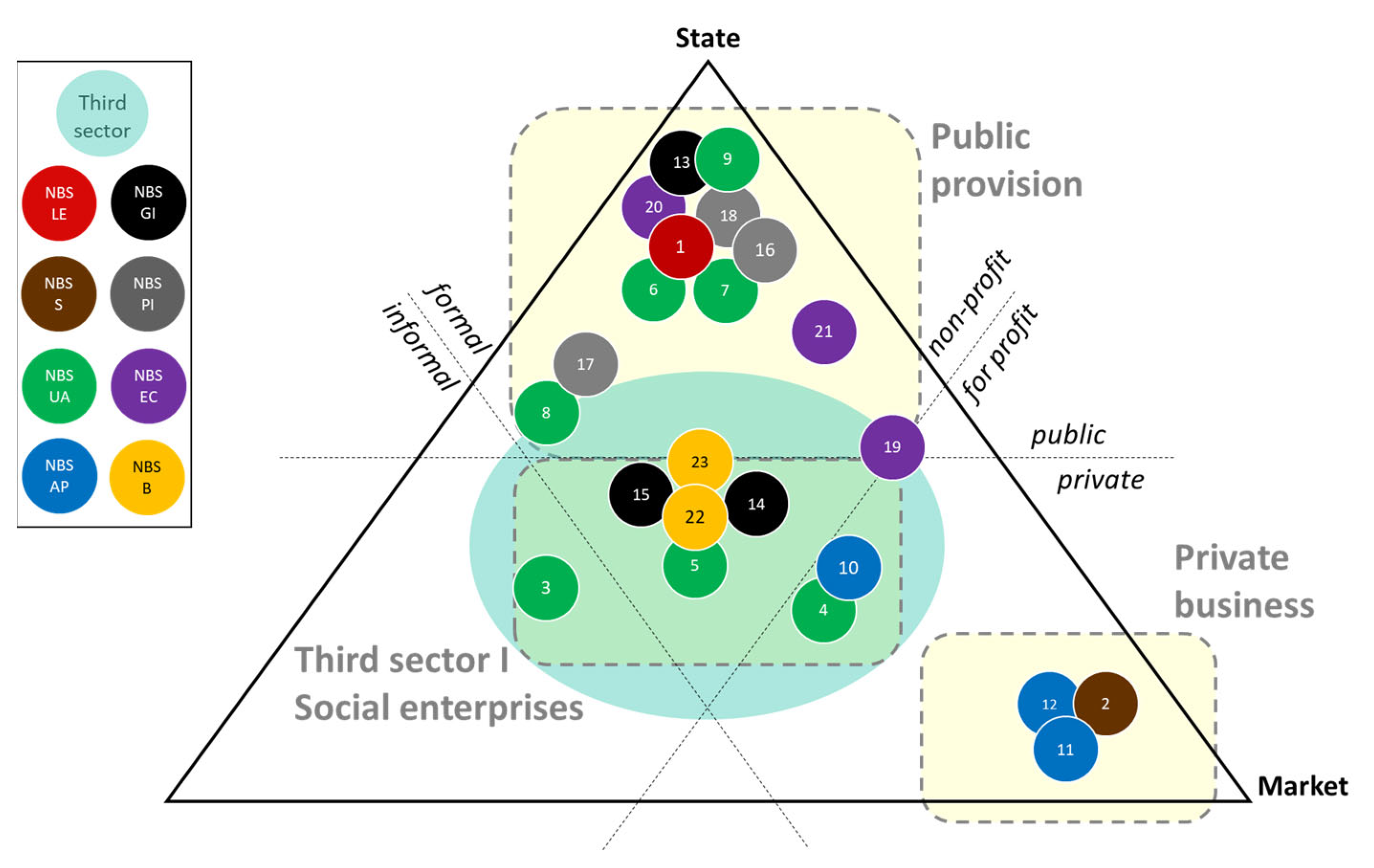
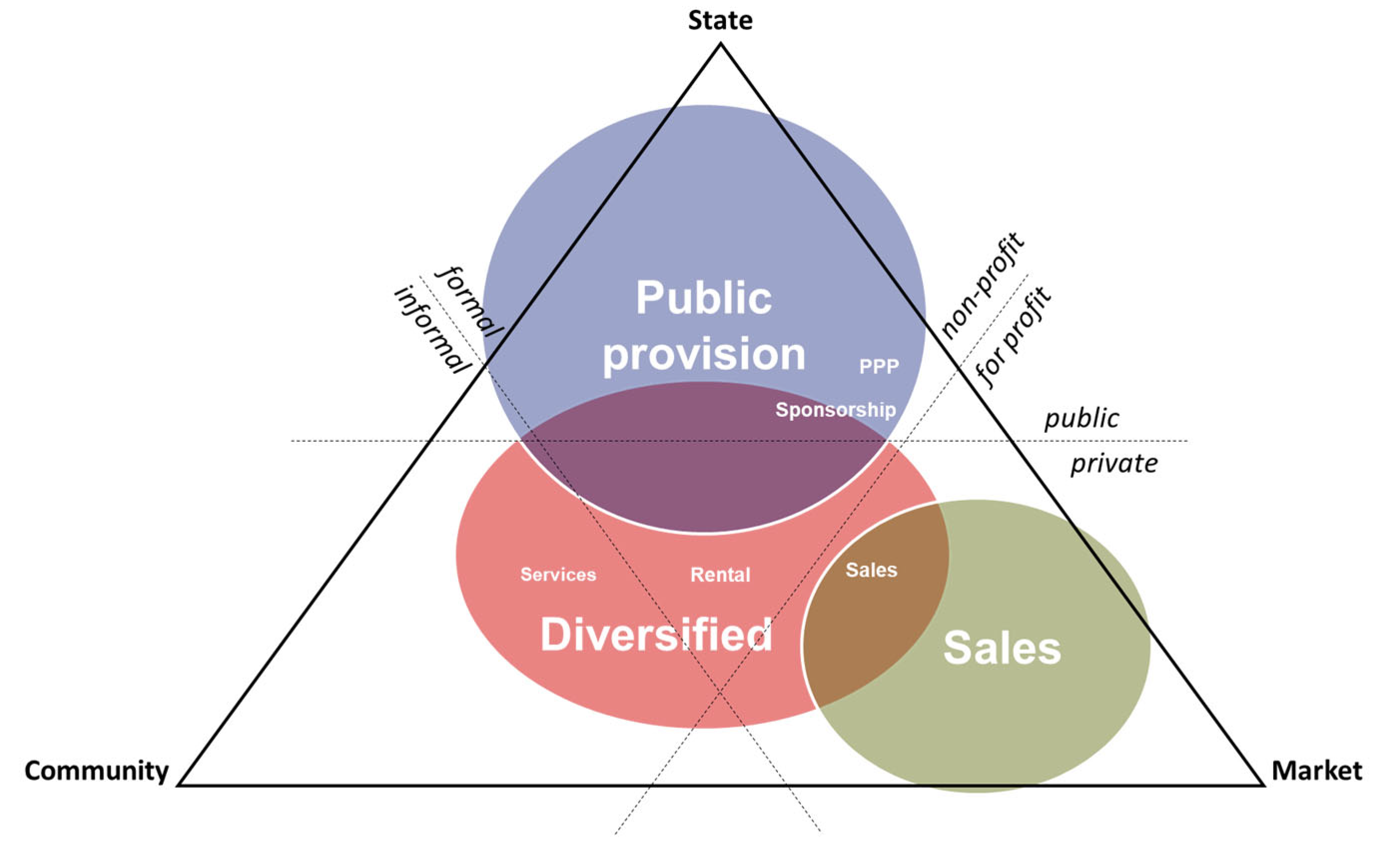

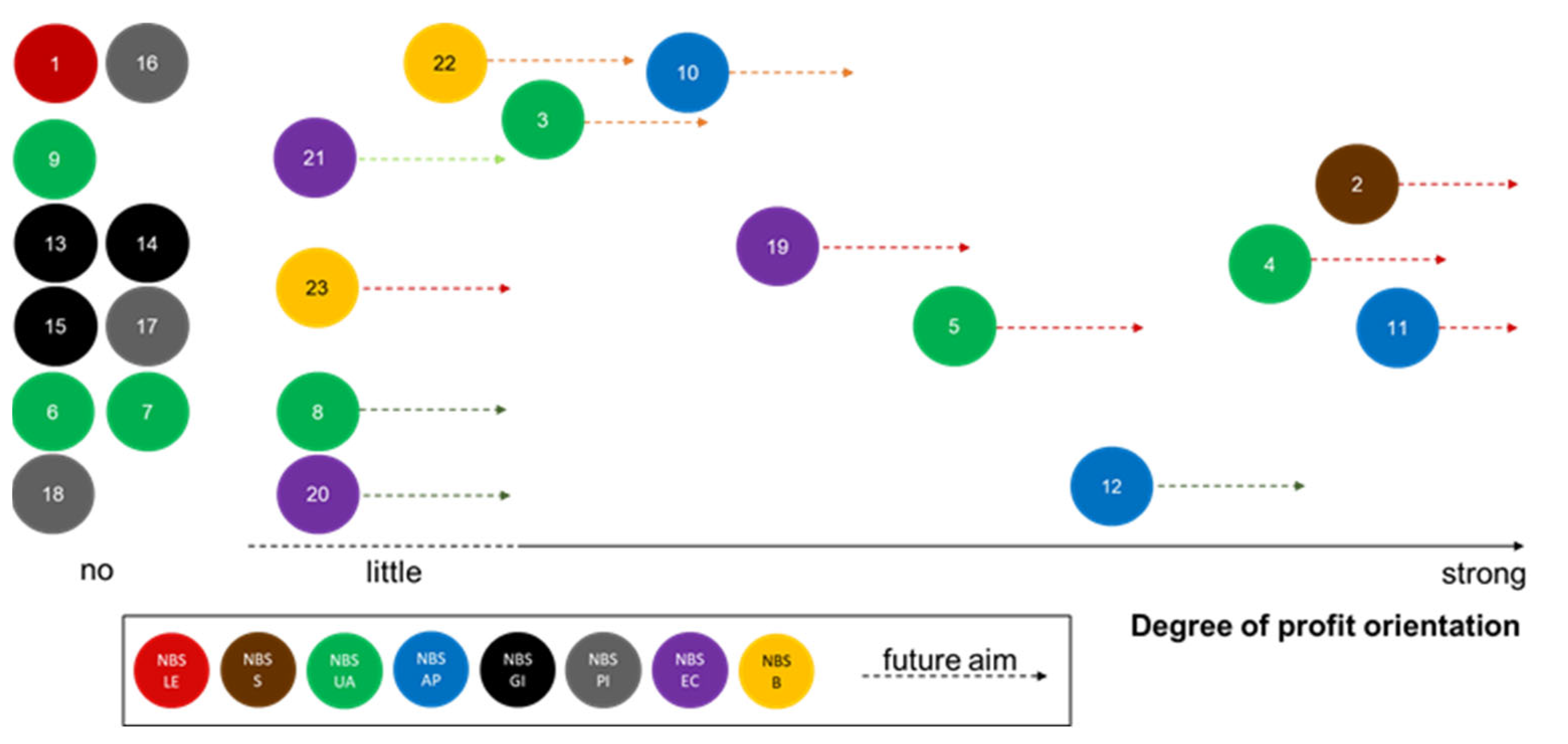
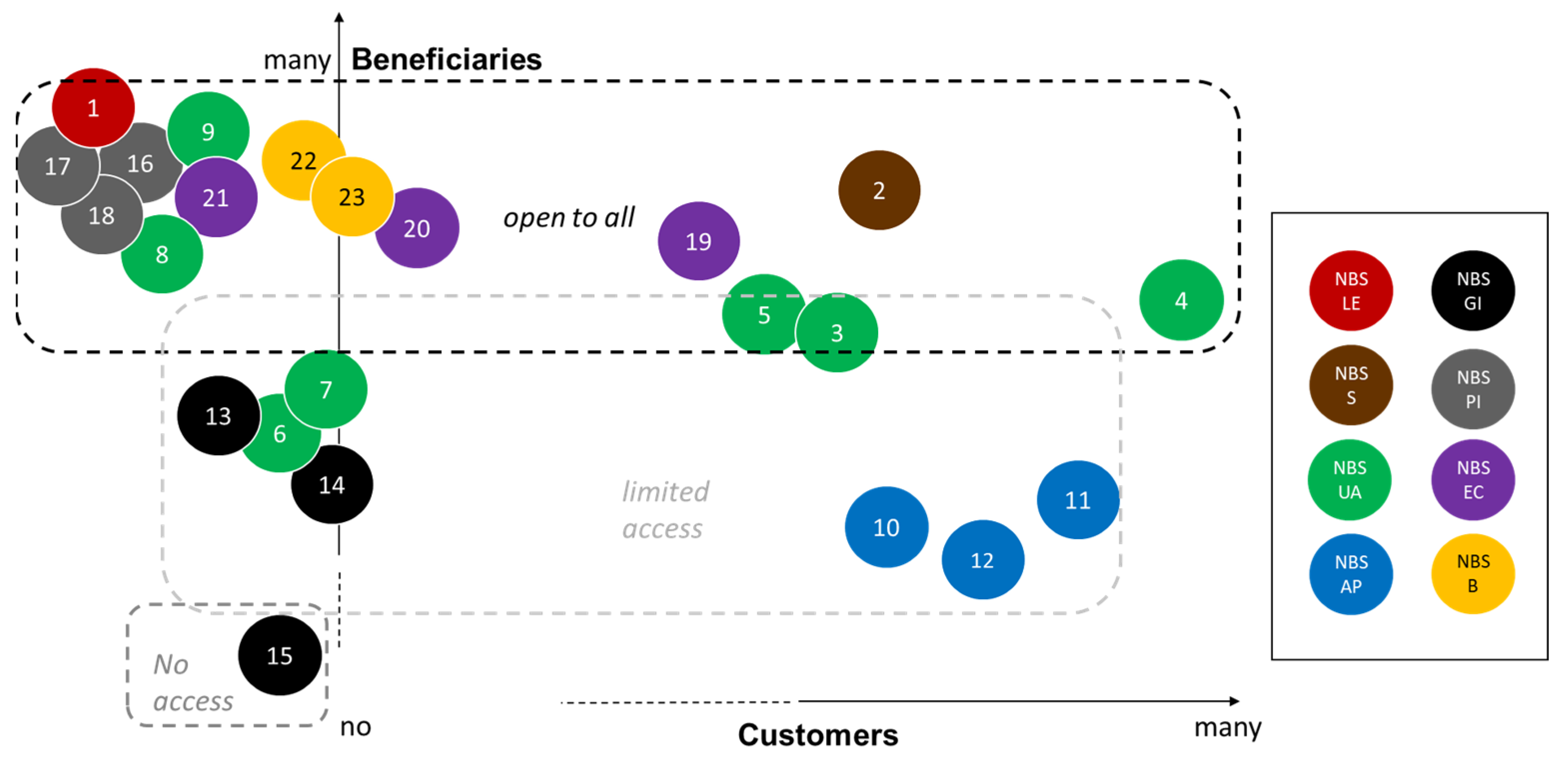
| NBS Type | Dortmund | Turin | Zagreb | Ningbo |
|---|---|---|---|---|
| 1: Leisure use and energy production (LE) | 1 | |||
| 2: New regenerated soil (S) | 2 | |||
| 3: Community-based urban farms and gardens (UA) | 3 | 4; 5 | 6; 7; 8 | 9 |
| 4: Aquaponics (AP) | 10 | 11 | 12 | |
| 5: Capillary GI on walls and roofs (GI) | 13; 14; 15 | 12 | ||
| 6: Access to post-industrial sites and renatured river corridors (PI) | 16 | 17 | 18 | |
| 7: Protocols and procedures for environmental compensation (EC) | 19 | 20 | 21 | |
| 8: Pollinator biodiversity (B) | 22 | 23 |
| Number | NBS Name |
|---|---|
| 1 | Sport devices urban park |
| 2 | New soil |
| 3 | Food forest |
| 4 | Urban farm |
| 5 | Raised-bed gardens |
| 6 | Therapeutic garden |
| 7 | Modernisation of existing garden |
| 8 | Info point |
| 9 | Urban lake planting |
| 10 | Aquaponics Dortmund |
| 11 | Aquaponics Turin |
| 12 | Aquaponics plus green wall and roof |
| 13 | Indoor green wall |
| 14 | Outdoor green wall |
| 15 | Green roof |
| 16 | Path for landfill access |
| 17 | Ecosystem path |
| 18 | Green corridor |
| 19 | Strategic tools |
| 20 | Urban planning guidelines |
| 21 | Water quality testing and management |
| 22 | Pollinator association |
| 23 | Butterfly gardens |
Disclaimer/Publisher’s Note: The statements, opinions and data contained in all publications are solely those of the individual author(s) and contributor(s) and not of MDPI and/or the editor(s). MDPI and/or the editor(s) disclaim responsibility for any injury to people or property resulting from any ideas, methods, instructions or products referred to in the content. |
© 2023 by the authors. Licensee MDPI, Basel, Switzerland. This article is an open access article distributed under the terms and conditions of the Creative Commons Attribution (CC BY) license (https://creativecommons.org/licenses/by/4.0/).
Share and Cite
Stork, S.; Pölling, B.; Lorleberg, W.; Morgenstern, R.; Feil, J.-H. Clustering Business Models of Heterogeneous Nature-Based Solutions Implementing Innovative Governance and Financing Concepts. Land 2023, 12, 2116. https://doi.org/10.3390/land12122116
Stork S, Pölling B, Lorleberg W, Morgenstern R, Feil J-H. Clustering Business Models of Heterogeneous Nature-Based Solutions Implementing Innovative Governance and Financing Concepts. Land. 2023; 12(12):2116. https://doi.org/10.3390/land12122116
Chicago/Turabian StyleStork, Simon, Bernd Pölling, Wolf Lorleberg, Rolf Morgenstern, and Jan-Henning Feil. 2023. "Clustering Business Models of Heterogeneous Nature-Based Solutions Implementing Innovative Governance and Financing Concepts" Land 12, no. 12: 2116. https://doi.org/10.3390/land12122116
APA StyleStork, S., Pölling, B., Lorleberg, W., Morgenstern, R., & Feil, J.-H. (2023). Clustering Business Models of Heterogeneous Nature-Based Solutions Implementing Innovative Governance and Financing Concepts. Land, 12(12), 2116. https://doi.org/10.3390/land12122116







